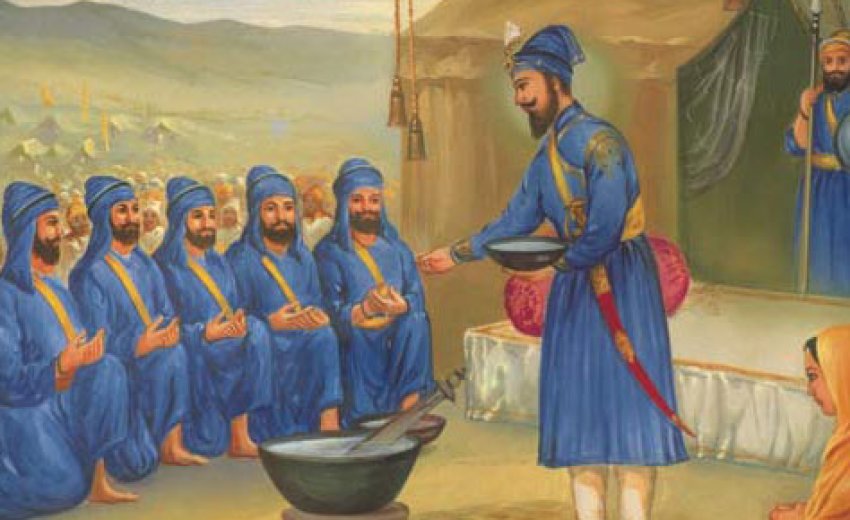The Khalsa of Guru Sahiban
The Journey of the Disciples of Guru Nanak (1469 - 1539) to Guru Gobind Singh (1666 - 1708).
This forms an introduction to the beliefs and values of the Khalsa and the Sikhs. The occasion of 1699 very much fresh in the minds of the Sikhs as they recall and reflect on those distant days with the Tenth Guru Nanak and the city of Anandpur Sahib .It offers a perspective on the meaning and living of the person embodying the notion of Khalsa.
The coming of age and 1699: the revelation of the Khalsa
The birth of Guru Nanak in 1469 ushered in an age of spiritual awakening formulating a coherent philosophy on the nature of the creation and the Creator. In its wake it led to political and societal change. Guru Nanak envisioned the spiritual persona as involved and involving of the community and wider society. For him the spiritual person had a duty and a responsibility to the community that went far beyond his/ her immediate circle. He gave humanity the first mantra1 that focused on the attributes of the Creator. The words below reflect my understanding of the 'Mool Mantra' and are not the literal translation;
 OneCreator who embodies truth and is self revealed as the Truth. HE is the doer. HE is fearless since fear is born out of deceit and lies. We fear those who are seen as different from us in size and form. The Creator is the Creator of creation and thus no one is unfamiliar to HIM and HE fears none. All belong to him and thus there is no equal to HIM. Enemies are born out of fear and persecution. These aspects do not apply to the Creator as HE bestows love and grace on HIS creation. HE is alone in HIS uniqueness but is not lonely as HE pervades all that is. HE is omniscient as well as omnipotent. HE does not exist within the bounds of birth and death since HE is infinite and has always been present. HE reveals HIMSELF through HIS grace.
OneCreator who embodies truth and is self revealed as the Truth. HE is the doer. HE is fearless since fear is born out of deceit and lies. We fear those who are seen as different from us in size and form. The Creator is the Creator of creation and thus no one is unfamiliar to HIM and HE fears none. All belong to him and thus there is no equal to HIM. Enemies are born out of fear and persecution. These aspects do not apply to the Creator as HE bestows love and grace on HIS creation. HE is alone in HIS uniqueness but is not lonely as HE pervades all that is. HE is omniscient as well as omnipotent. HE does not exist within the bounds of birth and death since HE is infinite and has always been present. HE reveals HIMSELF through HIS grace.
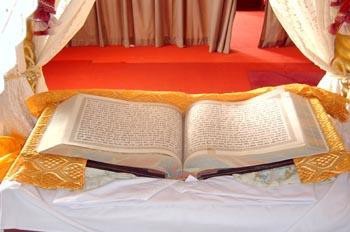 The principles outlined by Guru Nanak were adhered to and expanded upon by the anointed Gurus' after him. In all nine Gurus in human form followed. It was recognised that though they were different in form and age there was but One Light in all of them. The developing and the continuity of the principles was given a formal shape by the fifth Guru through the composition of Adi Granth around 1600's. This work was the culmination of the philosophy of Oneness of Humanity and the ONENESS of the Creator. Humanity was no longer to be viewed as divided by caste, creed, hierarchy, colour or faiths. All belonged to the Creator whose light shone through them. These aspects were all part of HIM and all divisions were enacted by our limiting vision and the narrowness of our thinking. The fifth Nanak2 invited humanity to come together and enrich the composition of Guru Granth Sahib through their contributions. This came to be understood as the concept of "Sagal Sang Hum Co Ban Aayee" (The whole world is joined to us by their relationship to the eternal being. There is no other but HIM in all that we see).
The principles outlined by Guru Nanak were adhered to and expanded upon by the anointed Gurus' after him. In all nine Gurus in human form followed. It was recognised that though they were different in form and age there was but One Light in all of them. The developing and the continuity of the principles was given a formal shape by the fifth Guru through the composition of Adi Granth around 1600's. This work was the culmination of the philosophy of Oneness of Humanity and the ONENESS of the Creator. Humanity was no longer to be viewed as divided by caste, creed, hierarchy, colour or faiths. All belonged to the Creator whose light shone through them. These aspects were all part of HIM and all divisions were enacted by our limiting vision and the narrowness of our thinking. The fifth Nanak2 invited humanity to come together and enrich the composition of Guru Granth Sahib through their contributions. This came to be understood as the concept of "Sagal Sang Hum Co Ban Aayee" (The whole world is joined to us by their relationship to the eternal being. There is no other but HIM in all that we see).
In his tenth incarnation the tenth Guru Nanak3 found himself looking forward to the time when the human shape will no longer be guiding humanity as the human form will always be in the cycle of birth and death. This was the concept that the First Guru Nanak had already stated through the following," Only those who have given up on attachment4 dare to follow me." The First Guru Nanak reflecting on his human form had said," The human body is but a temporary abode for the soul. It offers the opportunity to become One with the eternal Being. Meditate and pay homage to the Shabad5 for that is eternal and represents Waheguru." The Tenth Nanak followed this to its natural conclusion. The Shabad in the form of Guru Granth Sahib will always be present and will speak to the aspirations and thoughts of those who wish to listen and follow. He revealed the form and attributes of a 'whole person' and the qualities that would underpin this awakening of spirituality with the civic responsibilities.
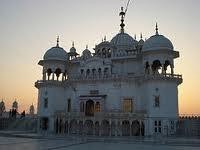 On 30th March 1699 (first of Vasiakh6) he gathered the Sikhs from across the lands and called upon them to reflect and answer questions that shook many of them to their foundation. The Sikhs had observed and learnt from the first Guru that they had to live simple lives and yet confront tyrants and superstition. They would do this through meditation and when necessary by giving their life. They had observed the Fifth Nanak being tortured with hot sand and burning fires and heard him proclaim," Dear Lord your nectar is so sweet and wondrous. Nanak beseeches YOU that YOU accept him at YOUR feet." The Sixth Nanak had shown the Sikhs that they could be the oceans of serenity without becoming passive. He led them into battles when the tyrants7 dared to enslave them. The Seventh Nanak showed the Sikhs that bearing of arms in itself does not encourage tyranny or bloodshed. Indeed he was to display the gentlest touch as he proclaimed," Oh Sikhs! take steps gently lest in your haste and carelessness you stamp on fragile hearts. Take care that you become the keeper and the nurturer." The Ninth Nanak displayed that truly the Guru belongs to humanity even if that meant that one would be tortured and put to death8. The Tenth Nanak thus came to a rich tapestry of valour, sacrifice and determination which led him to ask a simple question termed in very challenging language.
On 30th March 1699 (first of Vasiakh6) he gathered the Sikhs from across the lands and called upon them to reflect and answer questions that shook many of them to their foundation. The Sikhs had observed and learnt from the first Guru that they had to live simple lives and yet confront tyrants and superstition. They would do this through meditation and when necessary by giving their life. They had observed the Fifth Nanak being tortured with hot sand and burning fires and heard him proclaim," Dear Lord your nectar is so sweet and wondrous. Nanak beseeches YOU that YOU accept him at YOUR feet." The Sixth Nanak had shown the Sikhs that they could be the oceans of serenity without becoming passive. He led them into battles when the tyrants7 dared to enslave them. The Seventh Nanak showed the Sikhs that bearing of arms in itself does not encourage tyranny or bloodshed. Indeed he was to display the gentlest touch as he proclaimed," Oh Sikhs! take steps gently lest in your haste and carelessness you stamp on fragile hearts. Take care that you become the keeper and the nurturer." The Ninth Nanak displayed that truly the Guru belongs to humanity even if that meant that one would be tortured and put to death8. The Tenth Nanak thus came to a rich tapestry of valour, sacrifice and determination which led him to ask a simple question termed in very challenging language.
"You have as Sikhs been living a way of life that has been congruent with the teachings of the Guru Sahibs meditating on the qualities and attributes of Waheguru9 for over two hundred years since the appearance of Guru Nanak. Today I am asking those of you who no longer fear death and the demise of this humanly form to step forward."
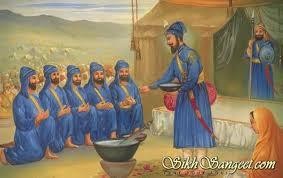 His call led five from the throng of people to come forward. These five became known as the first Panj Payarae10. Guru Sahib ushered them into a secluded tent from which they reappeared wearing similar garb. Their new appearance made them indistinguishable from each other as they stood next to their beloved Guru. At this point Guru Sahib performed a ceremony that has come to be known as the Khandae baatae di Pahuul11. He recited the Five12 Banis while stirring the contents with the Khanda. On completion of the recitations Guru Sahib gave the contents to the five and asked them to recite the following," Waheguru Ji Ka Khalsa; Waheguru Ji Ki Fateh" and with these words they came to understand that their life no longer belonged to them or to this flesh but to Waheguru in whose service they will spend their days.
His call led five from the throng of people to come forward. These five became known as the first Panj Payarae10. Guru Sahib ushered them into a secluded tent from which they reappeared wearing similar garb. Their new appearance made them indistinguishable from each other as they stood next to their beloved Guru. At this point Guru Sahib performed a ceremony that has come to be known as the Khandae baatae di Pahuul11. He recited the Five12 Banis while stirring the contents with the Khanda. On completion of the recitations Guru Sahib gave the contents to the five and asked them to recite the following," Waheguru Ji Ka Khalsa; Waheguru Ji Ki Fateh" and with these words they came to understand that their life no longer belonged to them or to this flesh but to Waheguru in whose service they will spend their days.
In coming to describe the revelation of the Khalsa to the wider community Guru Sahib observed the following; The Khalsa will be known for they will bear the stamp of the Guru by wearing on their person the Five Kakaar13. These are Kesh14 (known as the stamp of the Guru), Kanga15 worn in the Kesh, Kirpan16 worn on the torso, Kachera17 to cover ones modesty and lastly Kara18 to remind oneself of the presence of Waheguru in every sphere of one's life. Alongside these artefacts the Khalsa will be recognised for their daily routines which will include the recitation of the Five Baniyaan as described in the Rehat Maryaada (Sikh Code of Conduct) and the observance of basic principles that include;
The Khalsa will be known for they will bear the stamp of the Guru by wearing on their person the Five Kakaar13. These are Kesh14 (known as the stamp of the Guru), Kanga15 worn in the Kesh, Kirpan16 worn on the torso, Kachera17 to cover ones modesty and lastly Kara18 to remind oneself of the presence of Waheguru in every sphere of one's life. Alongside these artefacts the Khalsa will be recognised for their daily routines which will include the recitation of the Five Baniyaan as described in the Rehat Maryaada (Sikh Code of Conduct) and the observance of basic principles that include;
- Adherence to a simple life that comprises living within the community and avoidance of religious pilgrims.
- Food should be prepared and served without superstition and ritualism.
- Recognise and treat all as equal and from the same light and life source as you are.
- Recognise that men and women are equal.
- It is one's deeds that count and not one's birth right or social status.
- Every day and every moment is unique. There is no special day or time since all is within HIS will. One can start again as this acknowledges the fallibility of human form and thinking.
- Waheguru is unknown and unknowable since HE is infinite. We become aware of HIM through HIS grace.
The qualities that underpin the building blocks of the Khalsa will be;
- Dayaa in its literal sense refers to 'kindness', however envisaged within the concept of Sikhism and its use in Guru Ji's writings it lends itself to notions of empathy, understanding, being with another, availability, compassion for others as well as for self, connectedness to others and community. In this it reflects one of the attributes that a Sikh or a person must have to be human.
- Dharam reflects the notion of 'spirituality'. In Sikh philosophy the term encompasses such notions as oneness, morality, principles, integrity, stillness, and the union of internal ego to the eternal soul. This is the second attribute a person must have.
- Himmat reflects the notions of valour, bravery, fearlessness, courage while also representing problem solving and flexibility. Himmat requires one to accept behaviours that carry risks but can be managed and understood in the context. It employs concepts such as creativity and resilience to conjure up a different path and perhaps a different destiny. A spirit of adventure and curiosity pervades the person. In the face of overwhelming odds one has to confront one's own fears and this can only be done when one has the courage to accept one's fallibility as well as vulnerability and the loss of human form.
- Mokham represents the notions of persistence, effort, commitment and discipline. The notion exemplified by the above is of having a goal and pursuing this with discipline and effort to overcome the feelings of passivity and lack of motivation. One needs to develop the strength to move incrementally to attain the goal that one has set for oneself. The goal in its simplest form is the transformation of self to be one with the eternal being thus ending the separation that the body may have generated.
- Sahib represents the observance of the eternal being and the reflection that one is only but a momentary speck in the life of the universe and 'HIS' creation. Furthermore Sahib represents the ultimate perfection while retaining the mystery of its being. The reason for human life at its simplest is to co-join with the eternal from which we individually or collectively become separated through our actions. Life is about change and transformation through meditating on HIS name. In recognising this one is filled with humility and the knowledge that life is but a temporary state of being.
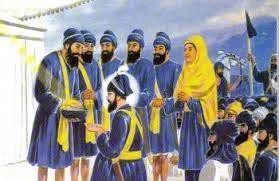 Incidentally these were also the names of the Panj Payarae who stepped forward in 1699.The Tenth Nanak19 said looking to the future," The Panj Payarae will always represent the values and qualities that I cherish for these represent the completeness of the human form."
Incidentally these were also the names of the Panj Payarae who stepped forward in 1699.The Tenth Nanak19 said looking to the future," The Panj Payarae will always represent the values and qualities that I cherish for these represent the completeness of the human form."
My grateful thanks to Bhai Guljar Singh (Canada Wale) for his guidance and support in preparing this article, and to those Sikhs who have kindly allowed the use of their images.
--------------------------------------------
Biblio:
1 This is the first verse of the morning recitation of Shabad Bani JAP JI Sahib as well as the first composition of Guru Granth Sahib (the WORD that enlightens us is the Guru.).
2 Guru Arjun Dev Ji
3 Guru Gobind Singh Ji
4 Attachment here refers to all things that bind us to a life that prevents us from attaining Oneness with Waheguru.
5 Shabad is that hymn that is the revelation of the Eternal Being as revealed to Guru Sahibs.
6 This in the modern calendar falls around the 13th of April.
7 The emperor of India deemed that the Sikhs were a threat to established order and religious practice. Under his orders the Fifth Nanak had already been tortured to death and now he attacked the Sixth Nanak to destroy the Sikhs forever.
8 Elders of Hinduism had sought refuge with the Ninth Nanak from the travails and retribution of the Mogul Emperor. To save their lives and their rights to practice their religion he was to give his own life. Today that place is marked by a Gurdwara in Delhi where he was eventually beheaded along with his three companions after they had been tortured for days.
9 Sikhs refer to the OneCreator by many names that represent His qualities and virtues. It is important to note
that the names represent our limitations and understanding. They do not represent the formless ONE. Sikhs use the word 'Waheguru' to express His immensity, awe and wonder.
10 Loosely translated it means the five beloved.
11 Khandae refers to the two edged sword which the Guru used to stir the contents of the bowl, baatae refers to the iron bowl in which Guru Sahib had put water and Maata Sahib Kaur added patashaae (sugar formed into sweets).
12 These are known as Jap Ji, Jaap, Tavparsaad Savayae, Ananad Sahib and Kabio Bach Benati Chopayee (Paatshahi Dasvien).
13 Kakaar is known as objects/ symbols all beginning with 'K'.
14 Unshorn hair referring to both head and beard.
15 Wooden comb
16 A small sword. The name refers to an object that offers hope and sanctuary. The sword's familiar function is to instil fear or enmity. Guru Sahib reframed the sword so that one could foresee it as the object of hope.
17 Long shorts worn with a draw string that ties them securely to the body and protects modesty.
18 An iron/ steel bangle worn on the hand that one uses most.
19 Guru Nanak was very explicit in his teachings that Sikhs should recognise the 'Shabad Guru'. He described his own sojourn through the world as 'one moment away from death'. This was reinforced by all the Gurus as they journeyed through the world. Guru Gobind Singh Ji when asked the question of who will follow him, replied," Listen O' Sikhs pay homage and observance to Guru Granth Sahib. In Shabad Guru you shall find the formless eternal Guru and in the Khalsa you shall find the figurative Guru.
Copyright @copy; RajVinder Singh Gill (2014)
